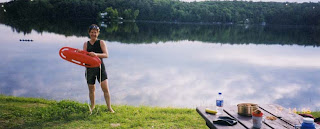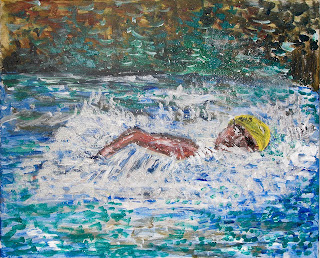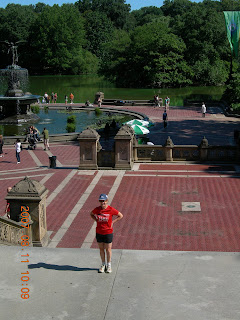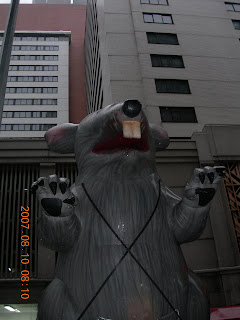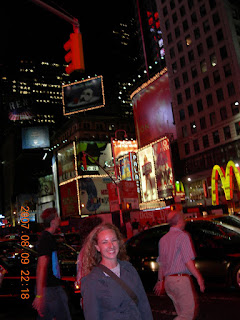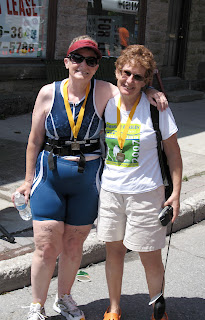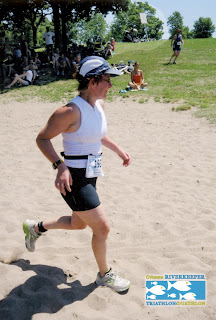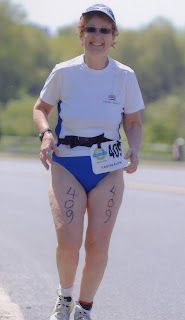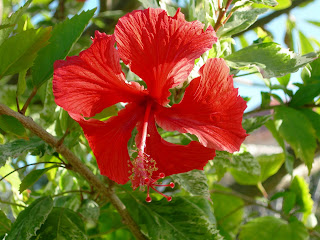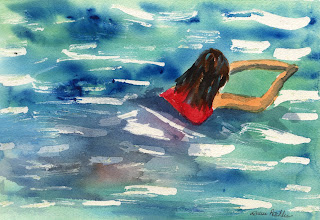
From: Louise Rachlis
Sent: Wednesday, July 5, 2006
Subject: Europe e-mail 1 – Fair warning
"Though there are some disagreeable things in Venice, there is nothing so disagreeable as the visitors."
Henry James
1843-1916
Last year Lorne and Louise followed in the Scandinavian footsteps of Hans Christian Andersen and Henning Mankell’s Inspector Wallander. This year, as we traverse parts of Spain, Italy and France, we (me) are inspired by Charles Dickens, who in the 1840s wrote Pictures from Italy:
"There is, probably, not a famous Picture or Statue in all Italy, but could be easily buried under a mountain of printed paper devoted to dissertations on it," he wrote. "I do not, therefore, though an earnest admirer of Painting and Sculpture, expatiate at any length on famous Pictures and Statues. This Book is a series of faint reflections - mere shadows in the water - of places to which the imaginations of most people were attracted in a greater or less degree, on which mine had dwelt for years, and which have some interest for all. The greater part of the descriptions were written on the spot, and sent home, from time to time, in private letters. I do not mention the circumstance as an excuse for any defects they may present, for it would be none; but as a guarantee to the Reader that they were at least penned in the fullness of the subject, and with the liveliest impressions of novelty and freshness."
Pretty smart, eh, that Dickens. I think he’ll go far as a writer. So that’s what you’ll get over the next few weeks, "faint reflections of our impressions," as we proceed July 5th to 24th, through Tina and Tom’s wedding in Ibiza (or Evissa in Catalon), Spain; a few days in Barcelona; a week in Venice; and a week in Aix en Provence.
I will be penning like Dickens rather than blogging, so I’ll try to get to an internet cafe about once a week. Forgive me for likely being unable to respond to you in transit, and for the typos incurred while Lorne paces outside the cafe while I finish up.
A happy summer to you all.
Louise and Lorne
From: Louise Rachlis
Sent: Friday, July 7, 2006 11:57 AM
Subject: Europe 2 - The uneventful journey of the Rachlis luggage
It was 11:30 a.m. Wednesday by the time our pre-flight preparations were done, and I could go for a last minute run along the Rideau Canal. I was admiring how beautiful it was - already looking at scenery through the eyes of a tourist - when a cyclist pulled up beside me and asked how to get to the University of Ottawa. My first thought was, "Oh, she can speak English." I had been mentally prepared for Spanish, Italian or French.
When we checked in at the airport, our luggage tags for Ottawa-Toronto-Frankfurt-Barcelona-Ibiza were so long the clerk had to split them in two on the handles, but at least the luggage was checked through to our final destination, and we wouldn’t have to reclaim it at any or each leg. Ever skeptical, Lorne kept asking different staff at the Frankfurt airport, our entry to the European Union, "Are you sure we don’t have to reclaim our luggage?" He of course also expressed doubt that, at the end of our 17-hour journey, we´d ever see the luggage again. His glass is half empty.
Toronto to Frankfurt was with Lufthansa, a "Star Alliance Partner" of Air Canada, on a Boeing 747. The plane was packed, and if they give a Consumers’ Choice Award for smallest seats, tightest lack of leg room and loudest wailing children among 500 plus passengers, they´d get gold. They even provide real metal cutlery, including knives, with the plastic meal because no one could pry themselves out of their cramped seats fast enough to do any harm. Getting out was hard enough when you have to go to the air-borne out house.
Real dishes and plates at the coffee kiosks in the Frankfurt airport where we spent a couple of hours! So civilized! It’s much easier to avoid creating paper garbage here than in North America. Inside the glass display case, the ordinary bread sandwiches were called "American". The whole grain, healthy, multigrain ones were called "German". They also sold frankfurters.
The worst part in transit for me was the several hours in the Barcelona airport, second from last leg. Jet lag thumped me and I just had to lie down. At least the benches didn’t have those are rest metal dividers and I could stretch out with my now indispensable, red, traveling neck pillow that I relied on the whole way. Lorne stood, rather, sat guard, he having been able to snatch several naps during the transatlantic leg.
Once we were actually on the delayed Air Iberia flight (flight time from Barcelona to Ibiza is less than an hour) we prepared by mentally rehearsing getting our rental car, getting used to a new car in a new country, finding our accommodation (at least it would still be daylight) and then finding Puck’s rented villa for a wedding guest get together that same evening. But first, pick up the luggage.
Walk past the palm trees, enjoy a minute’s sunshine and on to the luggage carousel. And watch. And wait. And watch as our two bright red suitcases with special ribbons so you can’t miss them on the conveyor belt don’t arrive. Lorne is so sweaty we have our own personal space. (I’m immune to it now. On second thought, no, I’m not.)
One bag is in Canada, and we have no record of the other, reports the clerk, proud of their excellent tracking system. We’ll call you. Don’t worry, this has happened before. (Including to five other people on our flight.) How can we reach you?
Instead of late afternoon sun to guide us, we are now driving at dusk. Lorne is re-learning the standard shift. Luckily the couple we stopped to ask how to put the car into reverse spoke enough English that they showed us how. You can imagine what they told their friends about the crazy tourists they met while walking home. We lurch along twisting roads, discovering the unique personality of our Renault diesel rental car as we attempt with difficulty to find Club Calla Lenya. (We were not delighted to learn that it is not in the town of the same name.) The Spanish phrase book is in the luggage. I was sure I thought of everything for this trip - except the right place to put it.
Skip forward an hour. We are now in our little stucco room, part of a six-plex unit as far from the main building as possible. (Sometimes we walked, sometimes we drove.) But minus everything that wasn’t in our carry-ons.
So this is a moral and a caution for you, dear friends and family. A carry-on filled with paperback novels is little comfort when what you really need is earplugs (guess why), a toothbrush, a party dress and a bathing suit. (Remember, this was before the scare in England regarding mixing innocuous-seeming liquids to make a bomb.)
But the fragrant hibiscus, oleander, and bougainvillea are bountiful and the sky is blue. Ibiza is truly beautiful, 572 square kilometres (one-fifth the size of Ottawa according to Lorne) of red sand, green pine-covered hills, deep blue water and white plaster walls on all the buildings. It was a trading seaport as early as 7 B.C. Now all the billboards advertise the popular-for-the-moment singers at the tons of nightclubs, including Privilege, The Largest in the World (in Guiness Book of Records according to the ad).
"Along the harbor streets, it’s possible to see the oddest characters whose sex condition is not easy to guess," says the free Ibiza pamphlet from the airport. It doesn’t refer to Lorne and Louise in their same three-day old Ottawa clothes. "It’s part of the island’s spirit of freedom brought by hippies ... Ibiza farmers knew how to accept these long-haired calmed youngs, who settled in the island during the Sixties," says the flyer. "Nowadays still happens the same, they have a kindly look at these craziness that sometimes seizes the island in summer." So there.
Note: Of 120 wedding guests from all over the world, we are now aware of at least six with lost ("delayed" in airline lingo) luggage.
Ibiza is popular with little children, too. The Director of Education inadvertently booked us into a ‘family resort’ 45 minutes from the main disco strip, the highlight being an evening puppet show in English and German. The good news – the kids go to bed early, and the food was all-inclusive, including three buffet meals a day and free snacks and drinks, including local alcoholic beverages, by the pool all day.
I’m off now to buy a bikini and flip flops, so I will fit in where "go-go dancers advance daily parties swinging the hips."
From: Louise Rachlis
Sent: Sunday, July 9, 2006 11:54 AM
Subject: Europe e-mail 3: How to get married in Ibiza
The invitation cautioned: "You cannot park at the hotel. The roads in Ibiza are very busy on Saturdays so expect delays. If you miss the shuttles, you’ll miss the wedding!"
Tina and Tom’s wedding was set for 6 p.m. at the Hotel Can Talais in San Carlos, Ibiza, Baleares. As directed, we parked near the old white church in the centre of San Carlos (population 100) and then headed to one of the minivans which proceeded through the pine trees up a long dusty one-lane dirt road to the top of a hill where the hotel overlooked the Mediterranean. The driver said to wait a minute for the dust to settle before opening the van door, and I understood why I’d seen a number of extremely dirty black car windshields in town with "wash me" and other comments finger written in Spanish.
The hotel was actually a large villa, formerly owned by the late British comedian Terry Thomas and now by his son. The main room has a life size painting of Thomas in traditional English riding gear. The house has just five large guest rooms and gets its clients only by word of mouth. "It’s a real find," said our British shuttle driver, who said she left the Midlands for Ibiza 16 years ago. She also advised that you never get used to the afternoon heat.
It was the kind of wedding setting you see only in movies, outdoor patio overlooking the sea, white clothed tables and chairs, sprinkles of flower petals everywhere, a soft breeze, large white umbrellas over each table to provide shade.
There was a brief non-religious (and non-binding—civil service performed in London last week) outdoor ceremony conducted by the groom’s friend, with passages written and recited by the couple. Following a Buddhist tradition they had picked up in Nepal, the best man (why doesn’t the bride marry the ‘best’ man?) handed a thin yellow rope out from the bride and groom and attendants, up and down each row to each of the guests - to symbolize that we were all tied together in friendship, the theme of their wedding after their nearly 10 years together. After 10 years, friendship is a pretty good deal.
There were small wooden fans placed on each seat for the guests at the outdoor ceremony, and wide orange ribbons tied the napkins at the meal, both of which went home with the guests, along with their own wrist-length pieces of the yellow cord. The tall blond bride looked like Grace Kelly in a slim low cut lace cream gown; the groomsmen each wore a single orange orchid blossom on their dark jackets.
The meal of local Spanish dishes served by attractive young British servers ended with chocolate tasting – platters consisting of six different tiny chocolate creations, like chili chocolate pots and heart shaped truffles.
By the way, our suitcases both finally arrived in Ibiza a day apart, Lorne’s the day after our arrival, mine the next day and fortunately just before the wedding, sparing my attendance in flip flops and the red/orange hippie wrap around skirt and top I bought here to go over my new orange bikini that says Espagne on the bum. (It’s not rude; it means "Spain" in Spanish.) We never did get to see much more of the island than the road to and from the airport. (The luggage ‘delay’ was caused by Air Canada in Toronto, which never got them on our transatlantic flight.)
We have just arrived back in Barcelona via Air Iberia, the last day before the Iberia pilots go on their annual strike. We’re planning our Barcelona activities, and I’ll tell you how it all works out in a few days. Buenas noches.
From: Louise Rachlis
Sent: Monday, July 10, 2006 11:59 AM
Subject: Europe 4: B-art-celona
When we got into Barcelona, the first thing (well, almost the first thing) I did was ask the hotel desk clerk to suggest a bar that we could walk to so we could soak up the local atmosphere, eat and, most importantly, watch the World Cup Final. He wrote down directions to the "Phil Harmonia" which turned out to be a traditional English pub named the Philharmonic, filled to over-capacity with loud, under-25 English, and a ton of cigarette smoke.
My only regular bar experience is the crowded and noisy annual TriRudy triathlon group silent auction at a pub in Vanier. This was just the same, except for the smoke. And the English accents. And the roof shattering cheering. (Lorne apparently has other and more extensive experience with bars which he hasn’t shared with me.)
The corners of buildings at most street intersections in old Barcelona are cut off, thus forming an attractive octagonal plaza effect. On a side street near La Rambla (famous wide boulevard with cafes down the middle) in downtown Barcelona, I’m drinking red wine and eating a baked potato in an English pub, with an BBC World Cup TV broadcast on a large screen, English only menus, Brit servers, and Lorne’s eating steak and kidney pie and quaffing Guinness. When in Rome …
This is a contrast to our usual Spanish experience so far where most Spaniards don’t speak fluent English. Gunnar, (bride’s uncle, Claes’ brother), one of many quadrilingual Swedes we know, says it’s because in Spain they dub the American movies into Spanish, but in Sweden (smaller population, smaller movie market) it’s Swedish subtitles, so they get to listen to - and learn - the English.
So our first evening in Barcelona was like a bonus trip to Britain, then manana (can’t figure out how to make the curly thing) after the Cup, back to Spain.
I’m particularly conscious of being judged as a tourist and needing to set a good example as a foreign visitor. At a local bar in San Carlos on Ibiza a bartender had been particularly unpleasant to Lorne after crankily serving him a cerveza and growling, in Spanish, "You blinkety blank New Yorkers … " then turned and wouldn’t pay him any more attention. We see good and bad behaving tourists and we (me, anyway) are especially trying to be polite, use the language whenever we know the words, even make sure our wet laundry is hanging neatly in the hotel room. It’s hard to break stereotypical images and harder when you can’t speak to each other.
I am sooo glad we are able to spend some time in Barcelona, which was just going to be a transit point. I knew about the art and architecture, but to actually see it is wonderful. Every building, sculpture, fountain is so grand. The thickly treed boulevards, iron and flower bedecked apartment balconies, motor scooters as vehicle of choice parked in rows on every sidewalk like bicycles were in China ...
We bought two-day on-off tour bus passes, broiling like Swiss Chalet chickens on the top of the double deckers because, if you’re cool inside, you can’t see the tops of the buildings. (Mad dogs and Englishmen .... )
On the shopping streets there is chain retail and chain food. Yes, McDonald’s. It is the art and architecture in public places that makes a city unique. (And it was such a big deal for Ottawa to ‘save the Cattle Castle’ and they wouldn’t even fix the Strathcona Park fountain for years!) On the city streets, the magnificent buildings tower above, and from the top of the double deckers, the miniature pedestrians fill the wide sidwalks below.
Antoni Gaudi’s early 1900s buildings and sculptures make me feel I could sculpt a building freestyle out of clay instead of measured iron and steel. His work is so creative and inspiring. The apartment building, with an inner court, curves everywhere, a window for every apartment room (including the storage room but not the maid’s room), marble tiled floors with more intricate patterns in public areas, was still, after over 100 years, in move-in condition. The exhibits showed how Gaudi designed his buildings with models composed of weights, counterweights, strings, sticks and so on rather than the traditional slide rule and T-square. A true genius.
We also saw the football stadium that seats more than 100,000 where Maradona and Ronaldinho played, and the stadium that was the site of the 1992 Barcelona Olympics.
For lunch we bought components at El Supermercat two doors down from our hotel. Always interesting to see the regional differences at the stores where locals shop in what food is emphasized and how they do things. For instance, after lining up at the cashier, I had to go back to the fruit and vegetable department and weigh the produce myself. The smell of the freshly baked bread was hypnotic.
Eating my piece of baguette and Spanish mejillons en escabeche (pickled mussels) in the hotel room, I had a flash of eating at my desk at work. I dripped highly colored food onto my clothes just like at home. I guess I haven’t been on holiday long enough. Tomorrow we will bus to and picnic at Bogatell beach on the Mediterranean, beside the city’s oldest cemetery with its centuries old crypts.
I have a few minutes left on my internet card, so I decided to write now while Lorne’s having his siesta. Please forgive as always typos, illiteracies and the nonsense from writing while the clock is ticking. (I know, it’s how I write at work all the time :-)
Buenas tardes. I’ll be back in touch from Venice!
---------------------------
From: Louise Rachlis
Sent: Thursday, July 13, 2006 4:55 PM
Subject: Europe 5: Alas, poor Venezia
Bonjourno (sic)
I’m writing a quick note standing up at the hotel clerk’s counter, because the other computer, the one in the TV room for guests to use, isn’t working and he’s letting me. Please ignore the lack of apostrophes - I can t find them on the Italian keyboard. (I added them after I got home.)
Three things I learned from a combination of Italian guidebooks while eating tapas and drinking wine at an outside cafe on La Rambla in Barcelona the night before leaving for Venice:
1. Venice is 100 islands, 400 bridges and 2,000 alleys. (All numbers grossly exaggerated we later found.) The city is shaped like a fish. (If you’re a mile up in the air looking down.) Addresses are hopelessly confusing. "Revel in getting lost." True. And that does panic Mr. Organization. Me, it’s my natural state.
2. "Avoid the area around the railroad station where it is less than pleasant ... Don’t stay in Mestre, a polluted industrial sprawl across the causeway."
3. The word "ghetto" comes from getti, the jets of the brass foundry located there before the word was inherited by Venice’s Jewish community when required to live on the site from 1516 to the late 1700s when the gates were opened by Napoleon and then reinstated by the Austrians.
Guess where last March the Rachlises reserved a hotel room for six days. You’re right. The answer is number 2. And the moral is - read the guidebooks BEFORE you make a reservation. (As with our luggage, we’re living these challenges just so everyone else will know what not to do :-)
So it was with some apprehension we approached our pre-paid Hotel Piave in Mestre near the railroad station. But nothing was going to ruin our visit to Venice. I’d read so many splendid novels set here in the Middle Ages. Who cared if the CAA Travel Book calls Venice, "Crowded and expensive, crumbling and shabby." As it turns out, they are right on.
We’re now entrenched in our dear devoid-of-charm Hotel Piave hotel room in Mestre, which bills itself as a "modern Venice hotel". That’s like saying that Bathurst and Wilson is the "modern Toronto". And it actually looks a bit the same. But we’re only sleeping there. (And Lorne doing his laundry.)
We had dinner outside three nights in a row at Ristorante Dante just down the street from the hotel. We just couldn’t manage the local custom of an afternoon nap at the height of the afternoon heat with a long and leisurely evening, beginning with dinner after 8. Especially since it meant a half hour bus ride back to the hotel and then another ride back to the islands. So we dined al Mestre. On the outside patio, under the stars, the first night listening to a table from Toronto expound on their adverntures. On each of the three nights, at 8:30 precisely, a bus load of tourists would arrive, be fed, and be back out the door by 9:30. We were in no hurry, which was lucky because for that hour it was hard to find our waiter. The food was great, the ambiance interesting since we were seated1 metre from a pedestrian / bicycle mall. By the third night the waiter thought we looked familiar. And then we were gone.
Eera squisito! (We’re language lagged. After struggling with the Spanish phrases and mastering "la cuenta per favor" to ask for the bill, it’s now "mi porta il conto per favoree". I’m getting hives from red wine so I m ALMOST ready to give it up. (Never did. And the hives went away.)
After wonderful breakfasts included with our rooms in Ibiza and Barcelona, the plastic packaged pseudo-croissants in "modern Venice" seem especially lame. Our tablemate one morning was a Dublin-area woman who had been here with her family for nearly a week and happily recited in her Irish lilt her entire itinerary and advice on everything such as that the churches for a fee will loan you a shawl or wrap so you will be modest enough to enter. (Actually shawls were provided gratis to women for the synagogue part of the Jewish ghetto tour.)
On our way into Venice the first morning we stopped at the train station as planned to buy tickets from here to Aix. To our surprise, you can’t get there by train from here - without at least four stops or an overnight in Geneva. We spent several hours investigating alternatives, all expensive and inconvenient. No direct flights – would have to stay overnight in Prague ! I’ll let you know how it ends up. (Found out it’s cheaper to hire a driver and car than to rent and drive yourself and about the same cost as flying or training without changes and stopovers. So that’s what we did. Moral: book all travel ahead when you have the time to discover what the options are and the cost is cheaper than the day-ahead price.)
Mestra is one railway station away from Venice (cost 1 euro each way) or, from our hotel’s bus stop, five bus stops away. (Bus pass is also good on the water buses.) So for the five days we went, by the time we were off the city bus and onto the water bus in old Venice, it was the heat of the day and the crowds were a sweating, heaving amoeba-like mass of gelato-eating, T-shirt buying, cell-phone talking humanity surrounding a nuclei of gift shops.
The ghetto and Jewish museum were quiet and uncrowded. You could be pretty sure that anyone going off the beaten tourist track into this area was Jewish. Weird feeling. It was interesting to tour two preserved synagogues from the 1500s. Both were essentially hidden inside innocuous looking buildings, on the second floor, with seating for about 100 people each. One way of telling there were synagogues inside was the presence of five (for the books of Moses) windows. Of the five original synagogues, three were Ashkenazi (eastern European Jews) and two Sephardic (middle Eastern and north African). Two of the Sephardic (the ones we saw) are actually still in use, one in the summer because it’s cooler and the other in the winter. The congregation consists mainly of elderly folks. There are a few jewelry and gift stores specializing in Jewishabilia, and one kosher restaurant on the edge of the canal looking as if it had been transplanted from suburban Jerusalem.
Most of the buildings in Venice are three, maybe four storeys high. No elevators. Except in the ghetto. When the island was completely built up, the only way to house a growing population was up. So here there are eight and nine storey buildings. Still no elevators.
Locking Jews up on their own island at night was a gesture by the Venetian government to the Pope and had the unintended consequence of protecting the Jews at night because that was when many believed we did our evil deeds. The only exception to the lock up was for doctors if needed for a medical emergency during the night. In return, the Venetian Jews were spared the Inquisition. (There are just 400 "affiliated" Jews (mostly elderly) in Venice today. The ubiquitous Lubovitchers from Brooklyn have an office here near the museum for the summer, but they don’t count, said our guide.)
Venice and the canals are substantial and impressive in their history, but the first day I was heartbroken. At first I thought the graffiti in suburban industrial Mestre was just a result of poverty in a run down area, but to see graffiti spray painted in so many locations on the buildings and bridges and alleyways of Venice itself, and overflowing garbage bins, brought me to tears. My dream city was under attack.
The water in the canals looked clean, counter to my fears of garbage and smells; it was the human-created detritus on the land that upset me. What a shame. I’m a dreamer, and, as always, a little late to the party, but I’m still glad I was there. A pui tardi (see you later) and Ciao.
________________________________________________________________________
From: Louise Rachlis
Sent: Friday, July 14, 2006 2:20 PM
Subject: Europe 6: Venezia - learning to love it
A quick note in keeping with today’s theme of glass-making, because I want to correct the impression yesterday’s ‘meltdown touristique’ might have given. As we get to know the city and the buses (land and water), and we know where to go and where not to go back to, Venice has a happier face than my initial pessimistic view. (Attribute it to dehydration.) There are beautiful shaded spots to sit and listen to the cicadas chirping, or to swing your legs over the fondamenta (a street that runs along the canal) and eat a box of strawberries beside the water, balconies to feel the breeze and watch the boats go by.
Murano Island (where glassmaking was moved in the 1400s to avoid fires in Venice) was quiet and pleasant. When they started blowing glass in Murano it was to imitate the first Chinese porcelains that had just reached Venice. Ironically today, many Murano shops have hand printed signs exhorting customers to avoid cheap Chinese imitations which, they claim, will destroy Murano’s glass industry.
At the Museo del Vetro there are examples of hugely ornate glass centrepieces for the Doges’ tables called deseri with one extreme example being a complete Italian garden with fountains, arches and flowerpots, and mythological theatre scenes. I guess they can still have such fragile glass bowls and goblets from the 15th century because there was no Air Canada then. (Couldn’t resist :-) I was looking at some glass bead necklaces and rings in the glass museum showcase, and thought hmph, pretty plain. Then I read the label that said they were from the first and 2nd centuries. And I had thought them to be current jewelry.
Surreal and fascinating, Venice has grown on me as we walk and take the vaporetti (water buses) around in the heat and the crowds. (Other places try to be Venice - I’ve water toured a town in China called the Venice of China, and Gothenbourg, the Venice of Scandinavia, but Venice with all its positive and negative components, they’re not.) Regards from the Venice of Venice.
________________________________________________________________________
From: Louise Rachlis
Sent: Sunday, July 16, 2006 10:27 AM
Subject: Europe 7: Happy End of the Plague
Buongiorno! (Now I know how to spell it correctly) Before leaving Ottawa, when we checked (of course too late) Tripadvisor.com for comments about our beloved Hotel Piave, "modern Venice hotel", one of several derogatory posts mentioned "the surly bald guy at the desk." So it was with some excitement we realized, "that’s him! The surly bald guy!" When I politely inquired about using the advertised feature of "internet access, see desk", he replied, "still not working. Go down the street."
"Down the street" there’s a corner small business run by a nice Pakistani man, basically a shabby room the size of a convenience store with booths and telephones used by immigrants for long distance calls. The computer he offered was in the back room beside the mop and pail, for 1.5 euros (no time limit!). Lorne sat on a folding chair in the waiting area in front and read the pocketbook he’d brought for the occasion since he knew he’d be waiting. "Why," he asks, "have the last three mystery books you’ve given me to read begun with the murder of a woman jogging?"
Anyway, I’m patronizing the corner man again so I can tell you about yesterday’s Festa del Redentore, an annual festival of thanksgiving for deliverance from a plague five hundred years ago. They build a temporary pontoon bridge across the canal to the Great Redentore Church. There was a long, decorated parade of boats, lanterns and other decorations are hung, and fireworks at midnight.
"Unbelievably ornate display of wealth, money lenders needed to raise money for the growing war effort against the Muslims, a massive display of weapons of mass destruction, prisons for those denounced by anonymous accusations ..." Plus ca change...
But no, we haven’t been reading the newspaper; we spent the morning listening to a seemingly endless audio commentary in the Doge’s Palace at St. Mark’s (excuse me, San Marco) Square learning history.
Quick tour of a Leonardo da Vinci exhibit housed in a church. Replicas of his papers accompanied by functioning models of what he had designed. For once Lorne took longer to get through an exhibit than I did. There might be something to the male / female brain theory.
Then, after a bikini swim in the waves of the Adriatic (Louise, not Lorne) on the small public beach of Florida-like Lido Island (which we liked so much we went back again the next day), we came back to St. Mark’s Square and had a drink al fresco while listening to a jazz combo and watching the pigeons eat from the hands of tourists from all over the world.
Venitians, like the rest of the world, now come in all variations, all speaking Italian. We had caffe decaffeinato and zupa di pesce alla marinara at a Chinese-operated paninoteca near the Rialto Bridge (they spoke Italian but not English, just like the sushi bar in Stockholm where the Japanese cooks spoke Swedish but not English), and we share the bus back each evening with young men of African origin and their giant bags of knock-off purses that they sell off blankets each evening at busy Venice pedestrian intersections. (The first time I saw the big bags, I thought they were nice boys going to the laundromat).
Oh, and you know those Peruvian Indians with the long black braids who play Andean music on a variety of pipes and recorders and sell their tapes and CDs in every major North American city? They’re here too, but for some reason are wearing Disney-concept North American Indian headdresses and fringed pants and jackets instead of their familiar white shirts and black pants. Whatever works …
In abundance: little pet dogs, pigeons, cloth bag folding shopping carts pulled by mature women in print dresses, gelato stands (1 scoop 1 euro, 2 scoops 2 euros, up to 3), and masked or maked-up (made-up (?) and costumed buskers, some on pedestals, some on stilts (!) posing as statues for coins. Rare to extinct: public benches, chairs and washrooms. You are expected to buy a drink and do your sitting (both kinds) at a cafe. The small public beach area on Lido had almost no facilities while next to it on both sides on extensive hotel beachfront, guarded by a security man, were cabanas, beach chairs, rental boats, change facilities and food outlets. And on Sunday, the little facility there was closed – no rental chairs, not even a working tap to wash off the salt water and change rooms closed so people held up beach towels while their friends changed clothes.
People push through lines here, none of that sheepish waiting your turn, so you have to fend for yourself. We start together getting onto boats or buses and have to look for each other inside as people crowd past and between us. Service is variable. An older North American Italian woman pushing a man in a wheelchair was yelling at a vaporetta attendant who told her to go over to the chart and look it up herself to find out if this boat went to St. Mark’s.
I thought two men chatting across the walkway from our evening restaurant were using sign language, but it turned out they were just talking and using their hands for emphasis. (Q: How do you make an Italian mute? A: Make him sit on his hands.)
When I get back I’m going to put a posting on Tripadvisor.com to counteract the ones that would have discouraged us had we seen them earlier. Looking back on six days and nights in Venice, each day I have become more attached. Ordinary adjectives don’t do justice to the uniqueness of this place. Pictures and descriptions in guidebooks are nothing like the real thing. I will think of Venice as we enjoy the chauffeured all day Tuesday drive along the Mediterranean coast to Aix en Provence.
____---------------------____________________________________________________________________
From: Louise Rachlis
Sent: Wednesday, July 19, 2006 12:39 PM
Subject: Europe 8: Aix and Pains
"Après moi, le deluge," said King Louis XIV, and in an afternoon thunderstorm, we arrived at the door of Hotel Kyriad in Aix en Provence, 25 km north of Marseille and a 7 hour drive from Venice along winding four-lane highway through dozens of tunnels, past terraced hills and gorgeous views of the Mediterranean. We had had conversations in English in Venice – at the kosher restaurant Gam Gam outdoors beside a canal with a couple from London, and on a bus boat with an American marine from San Antonio serving in Bosnia who was meeting his American fiancée in Venice for a 3-day romantic interlude and asked us for directions ! (Every sentence of his included the word ‘sir’ or ‘ma’am’ depending on whether he was addressing me or Lorne – so darn polite). It was so nice to meet up in Aix for an evening with Claes and Puck, the parents of the Ibiza bride, for meaningful dialogue, a nice change from the predictable conversation between us. (Typically, Lorne: Here’s all the things that can go wrong today. Louise: Shut up.)
Aix is like a small scale Paris. We had a wonderful meal outdoors, under cleared up sky: Except for breakfast, we haven’t eaten inside for weeks. (The title of this email refers to the excellent bread and everything else to eat here.) Puck and Claes had arrived in Aix a day ahead of us and were and heading to Amsterdam the next day. Puck had good advice to smooth our way:
- Don’t take the Aix tourist mini-train in the morning for sightseeing when street deliveries are being made - traffic jams. Go in the afternoon when it’s not as busy:
- On the way into the Cezanne exhibit, pick up an English brochure; it has the same information as the plaques, but inside they aren’t in English.
- Don’t get a Eurail pass in the summer because of the long lines for reservations. TGV Train Grand Vitesse is the way to go in France with beautiful shining cars and sleepers.
We actually followed advice number 1. Didn’t need the other two but good advice just the same.
It is 100 years since artist Paul Cezanne’s death and the region is in great celebration of the centenary with a variety of exhibitions, and tours of his childhood home, studio and everything in between including the coffee shop he frequented.
There’s a lot else to our stay in Aix (pronounced Aches (you know, aches and pains, including the ‘s’ – somehow a contraction of Aqua and Sextius, the latter being a Roman general who built an aqueduct 2000 years ago to bring the aqua from the hills to the city) including a crocodile farm (why, we asked the tour guide? – to attract tourists and to make leather for shoes and purses) plus day outings to Avignon and the Popes’ palace there, and to Arles.
In the old part of Aix (remember to pronounce the ‘x’) itself, only a 20-minute walk from our hotel we were told (40 if you are human like us), we discover le Cours Mirabeau, a road built in 1649 for horse drawn carriages and sedan chairs. It is lined with thick trees, 100 statues, cafes, fancy historic mansions from the 17th century with wonderfully intricate doors and embellishments, and huge ornate fountains. One fountain dating from 1734 spews warm water from a hot spring. Running off of the broad main streets is a maze of narrow, winding pedestrian streets (which cars sometimes used), crowded with shoppers, and towered over by 3- and 4-storey buildings with no front yards lining the streets, housing fancy shops selling caviar, wine, designer clothing plus boulangeries and cafes. There are of course the highly elaborate churches and convents, city hall, palaces, bell towers, and the requisite now disappeared (where they used to live) Jewish quarter. There are still remnants of the Romans from 1 A.D.
Aix is the county seat for Provence and full of very rich people. The narrow winding streets are lined with courtyard walls and building walls, looking pretty much the way they did four hundred years ago. But inside the walls – sometimes what appears to be several dwellings has become one. There are courtyards and even swimming pools inside. We saw people leaving one villa because the garage door had been left open and inside we saw a large open courtyard, circular driveway and a Maseratti car (worth a half million euros, Olivier told us). We’re not just out of their league. We aren’t even playing the same game.
Lorne has been dutifully washing his clothes in the sink each night, while I, who never perspire, had been saving mine. In Aix it was time to find a laverie. We traversed the narrow streets and finally found what we were looking for. As we were figuring out the instructions, another man doing laundry comes over to help in French. He switches to English when he realizes we are. Turns out the white bearded man with the large cross is Father Ronald Young, originally from California but now an Oblate missionary and teaching at St: Paul’s University around the corner from us in Ottawa. He’s living at the monastery in Aix to learn French and perhaps save a few souls: He’s going to write an article on his summer for me for our community paper The Mainstreeter. So here’s Lorne talking politics and sharing his N.Y. Herald Tribune with a clergyman from Ottawa. Lubovitchers in Venice, Oblates in Aix; every denomination is out to proselytize in the sunshine.
Sorry for the typos and cutting short of my stories. I’ll have to tell you in person. I don’t think I’ll be emailing again from here; the French keyboard is driving me crazy. It’s very different and slows me down too much to find the letters; and internet in Aix is 5 euros for 15 minutes. Instead, on our last week of vacation, I will stop and smell the lavender. Au revoir and all good wishes.....
_____
From: Louise Rachlis
Sent: Saturday, July 22, 2006 2:11 PM
Subject: La fin d’une semaine en Provence
Hi
I still can’t work on this strange keyboard, but I wanted to quickly record some more of our trip so we will remember it. We’re sitting over an absolutely fresh, just caught fish lunch in Avignon, and Olivier, our tour guide, is pontificating about the evils of the microwave and take-out coffee. "Why would you take it out? ... It takes just a few minutes to drink it ...When I was young, it was the height of rudeness to eat a sandwich on the street ..." He insisted on taking us to a real non-tourist restaurant that prepares food properly, and expostulated on everything from the carrots "right from the garden" to the fresh-pressed olive oil.
For our last few days here, we have been taking small guided trips outside Aix and thanks to Theriot and Olivier, and their charming French accents and idioms, we have learned a lot about Marseille where we spent Thursday, and the Avignon area Friday. Marseille is a huge, very old, "bouillabaisse" city, Theriot ‘s word for melting pot. Its downtown area has been revived and is worth a visit. The view from Notre Dame de la Garde church of Marseille and the mountains surrounding it is amazing. This according to our guide of Marseille who also lives there. According to Olivier, who lives in Aix and guides tours from there, Marseille is an unsafe dump.
For the trip to Avignon on Friday, there was just us, tiny Agnes Lan from Taiwan, who we spent the next two days with, and burly Rick James, from British Columbia, who is working here for four months as a maintenance mechanic on the local fire-fighting aircraft. Forest fires are a constant threat, and, the country-side being all built up, must be eliminated tout de suite. So, looking for smoke and dive bombing with water or chemicals are constant work.
The four of us, plus Olivier; a thin, medieval priestly-looking man in a Panama hat, spent the day in the vicinity of the Pont d’Avignon, formerly heavily fortified (big castle now a museum on one end) and the only crossing point between the ancient Kingdom of France and the Holy Roman Empire. (No, they don’t dance there.)
It was around 40 degrees at the 2000 year old Roman aqueduct, looking as good as new, but I hear it has been very hot in Ottawa too. Actually it has been 35 to 40C everyday, but it is a dry heat. Unless you stand near Lorne. Hail Caesar and pass the gelato. The lavender fields are pretty well faded, the sunflowers are wilted and only irrigated crops are surviving in the heat. But we’ve seen huge olive groves and apricot orchards, drunk too much Cote du Rhone regional wine and eaten tomatoes, olive oil and herbs at almost every meal.
Avignon was packed with people for the local theatre festival which brings in plays from all around the world. Advertising for plays included hanging posters everywhere, walking around in costumes and leading a donkey in the courtyard of the Popes’ Palace and elsewhere.
Saturday it was just us and Agnes with Olivier – a private tour! We spent the day in the Alpilles mountains, Saint Remy de Provence where Nostradamus was born and Van Gogh was hospitalized, and we saw both sites, and also in Arles, which is called the Rome of France because it has Roman amphitheaters and baths built by Julius Caesar. (They were on the winning side against Pompeii. Marseille, then called Marcellus, sided with the loser and Caesar razed it.) We walked around all morning and took photos at many of the spots which Van Gogh had painted. Reproductions of the paintings were conveniently placed on signs beside the real thing. The old buildings in Arles are half the height of those in Aix, and the town is also much smaller. We couldn’t afford to live there either.
They have bull fights in Arles, but they kill the bulls only once a year. This, we were told, was the civilized thing to do. (Not like you know who in the country next door.) We did see lots of bulls in pasture in the countryside. Except for the annual homicidal event, the task of the bull fighters is to capture a flag or ribbon attached to knives embedded in the bulls’ backs.
We had lunch in the medieval village of Les Baux de Provence, overlooking the rocky hills that Van Gogh painted, and eating fish soup. Out the window down below was a Michelin four star restaurant with a helicopter pad where the rich from Monaco fly in just for dinner and order from a menu with no prices. (If you have to ask you can’t afford it.) The town itself has been converted into a tourist village – no one lives there. Every house is now a café or shop.
After the two day tours and our own walking of Aix, we’ve now covered all the territory of Provence and have a better understanding of the area, its produce, scenery, crafts and history. Now to read the book. Must remember to reserve it at the library.
Sunday we walk the streets of Aix for the last time and have a splendid meal at the Deux Garcons where Emile Zola and Paul Cezanne spent their afternoons. Dessert is a frozen hollowed out lemon or orange stuffed with sherbet. Delicieux.
We fly to Barcelona, have just enough time for one last walk on La Rambla, and then a relatively uneventful three leg air journey home, where, believe it or not, our luggage is waiting for us, customs waves us through, and our taxi driver home assumes we are Italian because of our tans. A perfect ending for a glorious trip..
